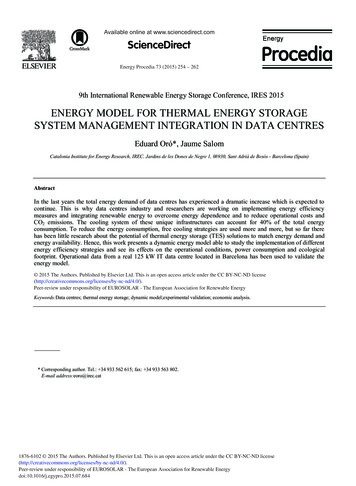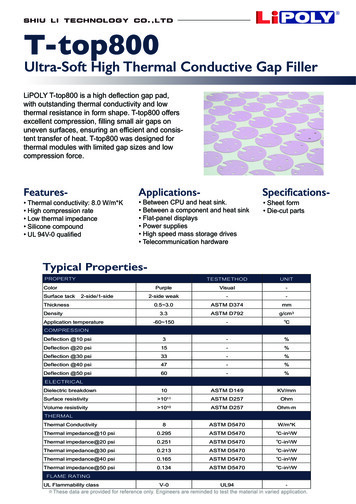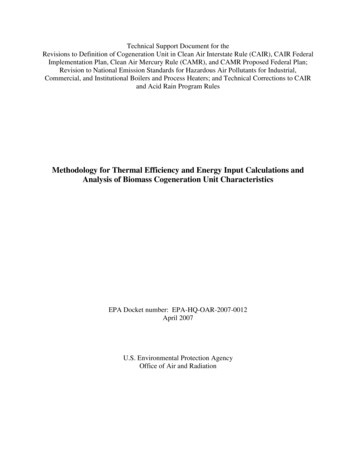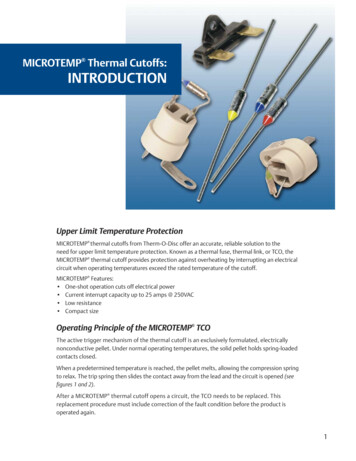
Transcription
Available online at www.sciencedirect.comScienceDirectEnergy Procedia 73 (2015) 254 – 2629th International Renewable Energy Storage Conference, IRES 2015ENERGY MODEL FOR THERMAL ENERGY STORAGESYSTEM MANAGEMENT INTEGRATION IN DATA CENTRESEduard Oró*, Jaume SalomCatalonia Institute for Energy Research, IREC. Jardins de les Dones de Negre 1, 08930, Sant Adrià de Besòs - Barcelona (Spain)AbstractIn the last years the total energy demand of data centres has experienced a dramatic increase which is expected tocontinue. This is why data centres industry and researchers are working on implementing energy efficiencymeasures and integrating renewable energy to overcome energy dependence and to reduce operational costs andCO2 emissions. The cooling system of these unique infrastructures can account for 40% of the total energyconsumption. To reduce the energy consumption, free cooling strategies are used more and more, but so far therehas been little research about the potential of thermal energy storage (TES) solutions to match energy demand andenergy availability. Hence, this work presents a dynamic energy model able to study the implementation of differentenergy efficiency strategies and see its effects on the operational conditions, power consumption and ecologicalfootprint. Operational data from a real 125 kW IT data centre located in Barcelona has been used to validate theenergy model. by byElsevierLtd.Ltd.This is an open access article under the CC BY-NC-ND license d/4.0/).Peer-review under responsibility of EUROSOLAR - The European Association for Renewable Energy.Peer-review under responsibility of EUROSOLAR - The European Association for Renewable EnergyKeywords:Data centres; thermal energy storage; dynamic model;experimental validation; economic analysis.* Corresponding author. Tel.: 34 933 562 615; fax: 34 933 563 802.E-mail address:eoro@irec.cat1876-6102 2015 The Authors. Published by Elsevier Ltd. This is an open access article under the CC BY-NC-ND nd/4.0/).Peer-review under responsibility of EUROSOLAR - The European Association for Renewable Energydoi:10.1016/j.egypro.2015.07.684
Eduard Oró and Jaume Salom / Energy Procedia 73 (2015) 254 – 2622551. IntroductionHere introduce the paper, and put a nomenclature if necessary, in a box with the same font size as the rest of thepaper. The paragraphs continue from here and are only separated by headings, subheadings, images and formulae.The section headings are arranged by numbers, bold and 10 pt. Here follows further instructions for authors.Data centres which they are facilities used to house computer systems and associated components aim forperformance, reliability and security 24 hours a day the 365 days a year, transforming them into a highly energydemand infrastructures. Data centres have traditionally had very controlled environments to increase reliability. Inthe American society of heating, refrigerating and air-conditioning engineers (ASHRAE) data processingenvironments thermal guidelines [1], the suitable environmental conditions for electronic equipment are provided.Additionally, Figure 1 shows the temperatures and RH recommended in a psychrometric chart. Besides temperatureand humidity, air pollution could also cause failures in data centres. Therefore ASHRAE [2] also providesparticulate and gaseous guidelines. In contrast to other types of building, data centres have mostly a constant coolingdemand independent of the hour of the day and the season. In the last years the total energy demand of data centreshas experienced a dramatic increase which still growing. This is why data centre industry and researchers areundertaking efforts to implement energy efficiency measures and to integrate renewable energy into its portfolio toovercome energy dependence and to reduce operational costs and CO2 emissions. In particular, the cooling systemcan account up to 40% of the total energy consumption and thus has a great potential for improvement [3].Moreover, due to the nature of some IT load such as web workload the cooling demand can vary during the day.Thermal energy storage (TES) system can play an important role to match cooling demand and production as well asto reduce operational expenses. Vos [4] showed that for a 300 kW IT facility the energy consumption related tocooling could be reduced by 20% and the energy costs could even be reduced with 35% by shifting the cooling loadfrom day to night. The implementation of a TES system using water as the storage material is taking advantage ofthe lower ambient air temperature and utilizing the off-peak tariff for electricity. This paper presents a validateddynamic model to predict the consumed power, the operational cost and the ecological footprint depending onmanagement strategies, the integration of TES systems and the data centre location.Fig. 1.ASHRAE thermal guides for Data Centre operating environments 0.2. Methodology2.1. Data center characteristicsAn operative data centre with an IT capacity of 125 kW is used to study the implementation of energy efficiencystrategies and to validate the dynamic energy model. The facility was constructed in 2006 and started operations in
256Eduard Oró and Jaume Salom / Energy Procedia 73 (2015) 254 – 2622007 for the Universitat Politècnica de Catalunya in Barcelona. It has a TIER II level of reliability which meansthat has redundancy in some of the equipment such as the chillers (N 1) and the PDU (2N). The facility which hasan IT room area of 285 m2 is located in the second basement of a University building and it is surrounded by aisleand other areas by its four sides. This characteristic allows considering the whitespace as insulated from the outside.Figure 2 shows the scheme of the data centre and the equipment distribution. The facility is composed by 70 racksof data and 12 racks of communication equipment. The theoretical maximal power consumption is 4 kW per rackbut at the present moment the real average power consumption is between 1.5 and 2 kW per rack. Some racks aredistributed in cold/hot aisle containment so recirculation (hot air is mixed with cold air before entering to the ITequipment) is decreased. Notice that some other racks are placed in the whitespace so recirculation and bypass (coldair is mixed with exhaust hot air decreasing its temperature) effect are present.Fig. 2. Data centre layout.The facility is connected to the public grid. The electricity goes through a transformer before feeding the IT andthe cooling equipment. There is also an emergency generator which is connected in parallel to the grid and in case ofenergy supply failure the switchgear can change the source to the emergency generator. Figure 3 showsschematically the main components of the infrastructure. Notice that all the electrical components are in thewhitespace. Therefore the cooling system is also responsible to cool down the heat from the electrical equipment.Fig. 3.Scheme of the power supply in the data centre.The whitespace refrigeration is done using five computer room air handling (CRAH) units which uses chilledwater from three water-air chillers. A raised floor is used to distribute the chilled air to the bottom of the racks and
Eduard Oró and Jaume Salom / Energy Procedia 73 (2015) 254 – 262the exhaust warm air leaves the room parametrically direct to the CRAHs as it is shown in Figure 2. The 3-wayvalve of the CRAHs controls the cooling exchange between the chilled water and the exhaust air and it is controlledby the return air (temperature and relative humidity) which is opened or closed depending on the desired workingconditions. Each unit keep a constant air flow rate to the IT room of 8500 m3/h while the total chilled water flowrate is 39.9 m3/h. There is also a buffer tank of 1 m3 in the supply chilled water to prevent temperature fluctuations.The main characteristics of the cooling equipment are listed in Table 1.Table 1.Specifications of main equipment.ChillerModelCooling capacity [kW]Rated EERWater flow rate [m3/h]STULZ 82277.72.613.3CRAHModelCooling capacity [kW]Energy consumption [kW]Air flow rate [m3/h]Uniflair TDCR 1200A372.58500Water pumpsEnergy consumption [kW]3Water flow rate [m3/h]422.2. Energy model descriptionThe dynamic energy model is based on a component-by-component approach using TraNsient System Simulationprogram (trnsys). Trnsys, developed by the Solar Energy Laboratory of the University of Wisconsin, is used tosimulate the behaviour and to predict the performance of transient thermal systems. Information from the equipmentmanufacturers, data centre operators and data collected directly in the facility was used to build the energy model.The energy model consists of main system components including chillers (type 655), pumps (type 114), crahs (type508c), pipes (type 31), etc. which are available in the trnsys library. Those components were connected according tothe system configuration already described and shown in Figure 4. The typical meteorological year (TMY2) datawas used to obtain the weather conditions in Barcelona. The TMY2 data sets are the typical values ofmeteorological elements for a one-year period from Meteonorm[5].257
258Eduard Oró and Jaume Salom / Energy Procedia 73 (2015) 254 – 262Fig. 4.Scheme diagram of the energy model for the data centre.3. Results and discussion3.1. Model validationFor operational data, the water return temperature (T w.return) was used as input of the model. The model wasvalidated by comparing the simulation results with the operational data during 12 hours. In the validation, the supplychilled water (Tw.supply), the return water temperature (T w.return), the cooling consumption (Pcooling) and the totalconsumption (Ptotal) were selected to validate the model. The actual chiller set points are different between them.Chiller 1 starts when the return water temperature is above 9.5 ºC, when it is higher than 12.5 then chiller 2 alsostarts and chiller 3 does not start till the return water is above 13.5 ºC. Moreover, the outlet water set point is set at8ºC. For the CRAH units, the return air temperature set point is set at 25.5 ºC. Figure 5 shows the modelled and thereal temperature and power values over a period of 12 hours. According to these results, the predicted values by themodel make good agreement with the actual operational data and therefore the consistency of the dynamic model isdemonstrated.
Eduard Oró and Jaume Salom / Energy Procedia 73 (2015) 254 – 262Fig. 5.Temperature and power comparison for model validation.3.2. TES implementation in data centresOnce the model was validated, it was utilized to study the implementation of TES systems into the data centreportfolio. As described before, the data centre has a redundant chiller which can be used to produce chilled waterwhen its energy efficiency ratio (EER) is higher and/or when the electricity cost is low and store that cold in theTES system. Figure 6 shows the schema of the cooling system at different operational modes. The redundant chilleris used to produce chilled water during the off-peak hours (night) and the cold is stored in the storage tank. Duringthe peak hours (day) the tank is discharged in order to decrease the return water temperature. Notice that in thissituation no additional costs are caused for the cold production, and only the costs for the storage by means of thestorage material and the infrastructure (storage tank, pumps, etc.) need to be considered. In the present work, wateris used as sensible storage material as it is cheap and available in many locations, has the best thermal properties,and possesses good long term stability.Fig. 6. Schema of the cooling system operating at night (a) and day time (b).A storage tank of 60 m3 has been implemented in the cooling system to evaluate the potential of TES systemimplementation in data centres. An optimization of the storage volumes is needed but it would be done in furtherstudies. Notice that in the actual situation the water flow rate through the CRAHs units has changed being reducedto 26.6 m3/h. This phenomenon may affect the temperature gradient of the water through the system. Moreover, thechiller 1 and chiller 2 water inlet set points (when they start) were modified to 11.50 and 12.50 ºC, respectively andthe chilled water set point has been raised from 6 to 8 ºC. This modification is done to compensate the reduction of259
260Eduard Oró and Jaume Salom / Energy Procedia 73 (2015) 254 – 262chilled water to the whitespace. The results after the implementation of the TES system are compared with areference case with same boundary conditions.Figure 7 shows the storage tank temperature and the chillers power consumption. On one hand, in night timeperiod, cooling power increases (the three chillers may be switched on) while the storage tank temperature decreases(charging). On the other hand, in day time and when the electricity price is higher, the overall cooling powerdecreases while the storage tank temperature increases (discharging). The stored cold is exchanged with the returnwater and therefore experiences a temperature decreasing before entering both chillers (Figure 8). Once the inletwater is lower than the set point for each chiller (11.50 and 12.50 ºC, respectively) they stop. Notice that the watersupply temperature when the TES system is implemented is 2ºC lower than the reference case. This is because allthe water is circulating for both chillers while in the reference configuration the water flow rate is divided in thethree chillers, increasing its outlet temperature till 10 ºC. This phenomenon would also affect the inlet airtemperature to the whitespace. Figure 9 shows the air inlet and return temperatures. As expected in the new scenariothe inlet air temperature is lower maintaining the temperature gradient inside the whitespace. Notice that the air inlettemperature to the whitespace is really low and it’s not really recommended. However, the data centre analysedpresents high values of bypass and recirculation and therefore in order to avoid hot spots they are working in thoseinlet ranges. Obviously it would be beneficial for the infrastructure to solve those phenomenon and then workingwith higher inlet air temperatures.Fig. 7. Storage tank temperature and cooling power consumed.Fig. 8. Supply and return water temperature.Figure 10 presents the total cooling consumption by means of the cooling production, air management, and TESsystem for both case studies. The cooling plant energy consumption is almost similar over the time but due toadvantage of using the off-peak electricity price the annual electrical costs are quite different.Fig. 9. Inlet and return air temperatures in /from the whitespace.Fig. 10. Power and energy consumption of the cooling system.
Eduard Oró and Jaume Salom / Energy Procedia 73 (2015) 254 – 262To calculate the total cost of the new cooling system, both operational and additional investment costs are takeninto account using reference data where the state of art of the technologies for TES systems are presented [6]. Table5 summarizes the investment costs to implement the different systems and Figure 11 shows the electricity price forfinal energy use. The exact value for electricity would depend on many factors such as favourable supply contracts(including long-term contracts), discounts for large-scale consumers, different levels of levies and taxes (includingexemptions for large-scale consumers), etc. Therefore, the use of this electricity price does not aim to predict theexact final cost but to demonstrate a valuable cost reduction using TES systems.Table 2: Investment costs for the TES system [6].TES systemStorage tank and systemStorage material (water)Investment cost-119.74·ln(VTES[m3])1,291.1 /m32.6 /m3 Fig.11. Electricity prices per kWh in Spain.Both models were also used to see the benefits of using TES in data centres over one year. The implementation ofthis concept causes slightly more energy consumption when compared to the reference case but the annual electricalcost for the overall facility is lower, being reduced 20%. Figure 12 shows the energy consumption and the annualelectrical cost for the overall data centre in both scenarios.Fig.12.Energy consumption and operational costs.For the evaluation of the investment the following indicators have been used: Net present value (NPV),discounted payback period and benefit to cost ratio [7]. The NPV represents the net total profit during the life of theproject, i.e., the difference between the operational profit and the total amount of expenses. Considering a life timeof 10 years, this value reaches almost 250000 . The discounted payback period represents the period of timerequired to refund the initial capital plus the interest that could be received from an alternative investment of thiscapital and is lower than 3 years. Finally the benefit to cost ratio which is defined as the ratio between the total profitand the total cost of the project during its lifecycle (10 years) is 4.22. These economic figures demonstrate thefeasibility of the implementation of TES into data centre portfolio.261
262Eduard Oró and Jaume Salom / Energy Procedia 73 (2015) 254 – 2624. ConclusionsDue to the high growth of IT and Internet over the last years, the electricity and cooling demands of data centreshave increased dramatically. To reduce the impact of the energy demand of these unique infrastructures, first energyefficiency strategies and second the implementation of renewable energy are opportunities to be considered. Thisstudy evaluates the incorporation of TES systems in the data centre portfolio to take advantage of operating duringperiords with higher EER and redundant chillers. To do so a dynamic energy model using trnsys was developed andvalidated with real data from an operative data centre with an IT capacity of 125 kW. The facility which has an ITroom area of 285 m2 is located in Barcelona (Spain). A comparison between the operational data and the calculatedtemperature and power showed a good agreement and therefore proved the consistency of the model proposed. Theresults show that short term TES is feasible when it is used to store the cold produced by the redundant chillerduring off-peak electricity price. The annual electrical cost for the overall data centre facility is being reduced about20%. The economic figures also demonstrate the feasibility of the implementation of TES strategies into datacentres. Considering a life time of 10 years the discounted payback period is lower than 3 years and the benefit tocost ratio after the life time is 4.22.AcknowledgementsThe research leading to these results has received funding from the European Union’s Seventh FrameworkProgramme FP7/2007-2013 under Grant Agreement nº 608679 - RenewIT.References[1] ASHRAE whitepaper, 2011 Thermal guidelines for data processing environments – expanded data center classes and usage guidance,Technical Committee (TC) 9.9, ASHRAE; 2011.[2] ASHRAE whitepaper, Gaseous and particulate contamination guidelines for data centers, Technical Committee (TC) 9.9, ASHRAE; 2009.[3] Oró E, Depoorter V, Garcia A, Salom J. Energy efficiency and renewable Energy integration in data centres. Strategies and modeling review.Renew Sustain EnergRevi 2000;42:429-445.[4] Vos D. Reducing the data center energy costs through the implementation of short-term thermal energy storage. Proceedings in the 8th IntRenew EnergStorConf (IRES 2013), Berlin; 2013.[5] Meteonorm. Irradiation data for every place on Earth. January 2015. Available online: http://meteonorm.com[6] Shrestha NL et al. Catalogue of advanced technical concepts for net zero energy data centres. Draft version. Published as Deliverable D4.3 ofthe European Project RenewIT. January 2015. Available online: http:///www.renewit-project.eu [Accessed November 2014].[7] Giaccone L, Canova A. Economical comparison of CHP systems for industrial user with large steam demand. Applied Energy 2009;86:904914.
distributed in cold/hot aisle containment so recirculation (hot air is mixed with cold air before entering to the IT equipment) is decreased. . Vos D. Reducing the data center energy costs through the implementation of short-term thermal energy storage. Proceedings in the 8th Int Renew EnergStorConf (IRES 2013), Berlin; 2013.











